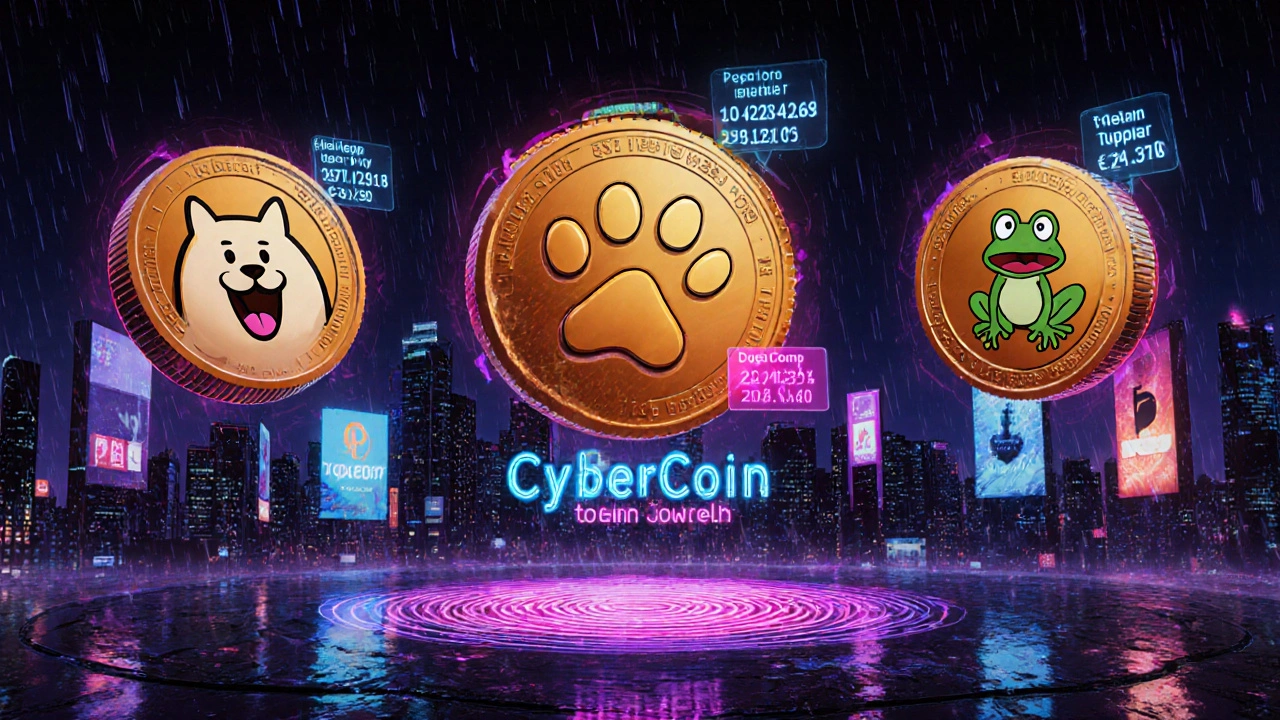When you hear “meme coins,” you probably picture a dog face or a silly internet joke turned into a digital token. They’re everywhere in crypto chat rooms and on social feeds, but what exactly are they?
Meme coins are cryptocurrency tokens that originate from internet memes, jokes, or viral trends rather than a core technical purpose. They usually start as a community joke, gain a cult following, and sometimes explode in value thanks to hype and speculation.
Why Meme Coins Exist
Unlike Bitcoin, which was designed as a decentralized store of value, meme coins have no deep‑tech roadmap. Their value comes from three main drivers:
- Viral culture: A meme catches fire on Twitter or TikTok, and developers quickly mint a token to ride the wave.
- Community sentiment: A passionate group of fans creates memes, merch, and charity drives, turning the token into a social movement.
- Speculative trading: Traders spot rapid price spikes and try to flip the token before the hype fades.
Top Meme Coins to Know
Not all meme coins are equal. Some have survived multiple market cycles, while others fizzled out within weeks. Below is a snapshot of the most notable ones as of October2025.
| Coin | Launch Year | 2025 Market Cap (USD) | Token Supply | Primary Use |
|---|---|---|---|---|
| Dogecoin | 2013 | $12.3B | 130B DOGE | Tips, charitable donations, tipping on social platforms |
| Shiba Inu | 2020 | $7.8B | 589T SHIB | d>DeFi ecosystem, NFT marketplace, community rewards|
| PepeCoin | 2021 | $310M | 1Q PEPE | Online gaming, meme‑based NFTs |
| Floki Inu | 2021 | $620M | 100Q FLOKI | Metaverse projects, community contests |
How to Buy Meme Coins Safely
Getting a meme coin is similar to buying any other crypto, but you’ll need a few extra checks because the market is more volatile.
- Set up a cryptocurrency wallet that supports ERC‑20 or BEP‑20 tokens, depending on the coin.
- Hardware wallets (Ledger, Trezor) give the best security.
- Software wallets (MetaMask, Trust Wallet) are easier for beginners.
- Choose a reputable exchange that lists the meme coin you want. Major exchanges (Binance, Coinbase) have stricter listing standards, while smaller DEXs (Uniswap, PancakeSwap) may host newer tokens.
- Buy a stable cryptocurrency like USDC or ETH first; then swap it for the meme coin on the exchange or DEX.
- Watch the liquidity pool depth - shallow pools cause huge price slippage.
- Transfer the tokens to your personal wallet as soon as possible. Leaving them on an exchange increases the risk of hacks.
- Double‑check the destination address; a typo can mean permanent loss.

Risks Unique to Meme Coins
Because meme coins are driven by hype, they carry a set of dangers that differ from traditional crypto projects.
- Pump‑and‑dump schemes: Coordinated groups buy large amounts, push the price up, then dump on unsuspecting buyers.
- Low market cap & liquidity: A small amount of selling can crash the price overnight.
- Rug pulls: Developers can abandon the project, withdraw all funds from the liquidity pool, and disappear.
- Regulatory scrutiny: Some jurisdictions treat meme tokens as securities, exposing holders to legal risk.
Understanding tokenomics-how the supply is distributed, whether there’s a burn mechanism, and who controls the contract-helps you spot red flags.
Regulation and Legal Landscape
Governments are catching up with the meme‑coin craze. In the U.S., the Securities and Exchange Commission (SEC) has warned that many meme tokens could be classified as unregistered securities if they promise profit based on the efforts of the developers.
European regulators follow a similar approach, focusing on anti‑money‑laundering (AML) compliance for token issuers. While no specific law bans meme coins, exchanges that list them must perform KYC checks on users.

Future Outlook: Will Meme Coins Survive?
Predicting the longevity of any meme coin is tough, but a few patterns are emerging:
- Community‑driven ecosystems: Tokens that evolve into functional platforms (e.g., ShibaSwap for Shiba Inu) tend to retain value longer.
- Brand partnerships: When a meme coin aligns with a mainstream brand or celebrity, it gains a layer of legitimacy.
- Regulatory pressure: Tightening rules may force exchanges to delist the most risky tokens, shrinking the market.
In short, some meme coins will become permanent fixtures of the crypto world, while others will fade after the next viral wave. If you decide to dip your toes in, treat them like high‑risk speculative assets-only invest money you can afford to lose.
Key Takeaways
- Definition: Meme coins are crypto tokens born from internet jokes and viral memes.
- Value drivers: Community hype, viral momentum, and speculative trading.
- Risks: Pump‑and‑dump, low liquidity, rug pulls, and regulatory uncertainty.
- How to buy: Use a secure wallet, choose a reputable exchange, watch liquidity, then transfer to your wallet.
- Future: Survival hinges on community utility and regulatory acceptance.
Whether you’re looking for a quick adrenaline rush or a long‑term community experiment, meme coins offer a unique blend of culture and finance. Stay curious, stay cautious, and remember that the line between a joke and a serious investment is often thinner than you think.
Frequently Asked Questions
What exactly is a meme coin?
A meme coin is a cryptocurrency token that originates from an internet meme, joke, or viral trend rather than a technical innovation. Its price is mainly driven by community hype and speculative trading.
How do meme coins differ from Bitcoin or Ethereum?
Bitcoin aims to be a decentralized store of value, while Ethereum provides a platform for smart contracts. Meme coins lack a core utility and usually have no distinct technological advantage; their value comes from social sentiment.
Are meme coins a good investment?
They can yield massive short‑term gains, but the risk of total loss is high. Treat meme coins as speculative assets and allocate only a small portion of your portfolio.
How can I buy a meme coin safely?
First, set up a secure wallet. Then, use a reputable exchange or a decentralized exchange (DEX) with sufficient liquidity. Transfer the tokens to your personal wallet immediately after purchase.
What are the biggest risks associated with meme coins?
Pump‑and‑dump schemes, low liquidity, rug pulls, and possible regulatory actions are the primary dangers. Always research tokenomics and the team behind the project before investing.
Do meme coins face any legal restrictions?
While most meme coins are not outright banned, regulators in the U.S., Europe, and Asia increasingly view them as securities if they promise profits based on developer effort. Exchanges may require KYC and may delist risky tokens.


Written by Eldridge Fairweather
View all posts by: Eldridge Fairweather